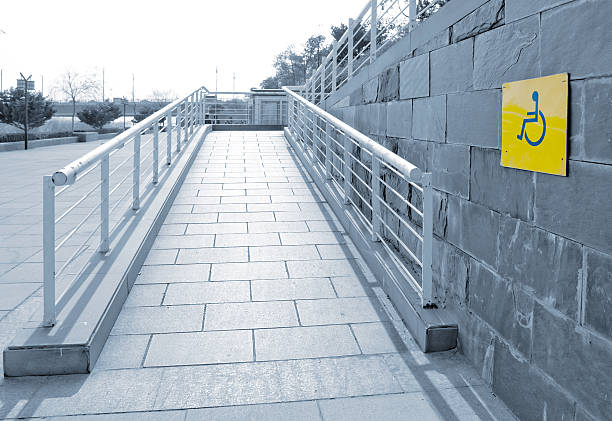Industrial and factory settings can be full of uneven surfaces, loading docks, and machinery with varying heights. While these elements are crucial for production, they can also create significant barriers for employees with mobility limitations or those using equipment like pallet jacks and carts. Thankfully, access ramps offer a simple yet impactful solution, promoting accessibility, safety, and ultimately, increased efficiency in these environments.
Benefits of Access Ramps in Industries and Factories:
- Enhanced Accessibility: Ramps eliminate physical barriers, allowing employees of all abilities to navigate the workplace freely. This fosters a more inclusive environment and ensures everyone has equal access to workstations, machinery, and break areas.
- Improved Safety: Stairways and uneven transitions can be a major cause of slips, trips, and falls in industrial settings. Ramps create a safer and more predictable walking surface, reducing the risk of workplace injuries.
- Increased Efficiency: By eliminating the need to find alternative routes or lift heavy equipment over obstacles, ramps streamline workflows and enhance overall productivity. Workers can focus on their tasks without unnecessary delays or safety concerns.
- Reduced Equipment Wear and Tear: Constantly lifting or maneuvering heavy equipment across uneven surfaces can damage them over time. Ramps provide a smoother transition, minimizing wear and tear on machinery and extending its lifespan.
- Compliance with Regulations: The Americans with Disabilities Act (ADA) and similar regulations in many countries mandate accessibility standards in workplaces. Installing access ramps ensures compliance with these regulations and avoids potential legal ramifications.
Strategic Placement of Access Ramps:
To maximize their impact, access ramps need to be strategically placed throughout the industrial or factory environment. Here are some key considerations:
- Identifying Barriers: Conduct a thorough review of the workspace to identify all potential barriers, such as raised platforms, loading docks, and uneven walkways. Prioritize high-traffic areas and locations crucial for workflow efficiency.
- Choosing the Right Ramp Type: Different ramp types cater to various needs. Consider factors like weight capacity, incline, portability, and surface material when selecting the most suitable ramp for each location. Permanent ramps made from durable materials like steel or concrete are ideal for high-traffic areas, while lightweight, portable handy ramps offer flexibility for temporary needs.
- Following Safety Guidelines: Ensure ramps meet recommended incline ratios and have slip-resistant surfaces. Install handrails on both sides for added stability. Clearly mark the presence of ramps with signage for better visibility.
- Maintenance and Upkeep: Regularly inspect access ramps for damage or wear and tear. Address any issues promptly to ensure they remain safe and functional.
Examples of How Ramps Benefit Specific Industries:
- Manufacturing: Ramps provide safe and easy access to raised platforms where machinery is operated or parts are assembled. They also facilitate the movement of heavy materials and equipment between different production zones.
- Warehouse and Distribution: Loading docks are a common access point for heavy goods. Ramps ensure smooth and safe loading and unloading of trucks and pallets, preventing injuries and streamlining warehouse operations.
- Chemical and Food Processing Plants: These facilities often require frequent cleaning and maintenance of equipment at various heights. Ramps provide safe access for workers and cleaning crews to reach elevated areas without compromising hygiene standards.
Beyond the Basics: Optimizing Access Ramps for Industrial Applications
While the core benefits of access ramps are clear, there are additional considerations to optimize their use in demanding industrial environments:
- Heavy-Duty Construction: Opt for ramps built with robust materials like steel or industrial-grade plastic to withstand heavy loads and constant use. Consider the weight capacity of the ramp when selecting it for specific applications.
- Surface Considerations: Beyond slip resistance, choose a surface material suitable for the industrial setting. For example, textured steel plates might be ideal for areas prone to spills or grease, while rubberized surfaces may offer better traction in damp environments.
- Customizable Solutions: For unique applications or challenging layouts, consider custom-designed ramps. These can offer a perfect fit for specific machinery or loading dock configurations, maximizing accessibility and safety.
- Integration with Existing Workflows: Plan ramp placement to minimize disruption to existing workflows. This may involve strategically positioning ramps to avoid blocking high-traffic areas or doorways.
- Employee Training: Train employees on the proper use of access ramps, especially those with specific weight limitations or incline ratios. This ensures they understand safety protocols and maximize the benefits of the ramps.
Additional Considerations for Specific Industries:
- Food and Beverage Manufacturing: In addition to standard considerations, choose ramps with smooth, easy-to-clean surfaces to maintain hygiene standards. Opt for corrosion-resistant materials to withstand frequent washdowns and cleaning procedures.
- Chemical Processing Plants: Chemical spills and exposure are potential hazards. Select ramps made from materials resistant to common chemicals used in the facility. Consider incorporating drainage systems within the ramp design to prevent chemical accumulation.
- Logistics and Distribution Centers: Prioritize high-weight capacity ramps for efficient loading and unloading of heavy cargo. Ensure ramps are wide enough to accommodate large pallets and machinery.
Van Ramps: Essential Tools for Safe and Efficient Operations
Van ramps are indispensable tools in industries and factories, providing a secure and efficient means for loading and unloading goods from vans and trucks. These ramps eliminate the need for manual handling, reducing the risk of injuries and accidents. By creating a smooth transition between the ground and the vehicle, van ramps ensure that equipment and materials are moved safely and without damage. Additionally, van ramps can improve productivity by streamlining loading and unloading processes, allowing operations to run more efficiently.
The Future of Access Ramps in Industry:
Technological advancements are continuously improving access ramp functionality:
- Self-Leveling Ramps: These ramps automatically adjust their incline to match the height of the loading dock or platform, creating a smooth transition regardless of variations in truck height.
- Modular Ramp Systems: These systems allow for the creation of customized ramp configurations by combining prefabricated modules. This offers greater flexibility for adapting ramps to specific needs within a facility.
- Smart Ramp Monitoring Systems: Sensor-equipped ramps can collect data on usage patterns and potential safety hazards. This data can be used to optimize ramp placement and identify areas for improvement.
By embracing these advancements and strategically incorporating access ramps, industries and factories can create a safer, more inclusive, and ultimately, more efficient work environment for all employees.
Access ramps are not just about creating an accessible workplace; they are a smart investment that enhances safety, efficiency, and overall productivity in industries and factories. By removing physical barriers and promoting a safer work environment, ramps empower employees, reduce workplace injuries, and contribute to a smoother flow of operations throughout the facility.
Also Read: The Rise of VoIP in the Telecom Industry.
Stay tuned for more news and updates on Infinite Insight Hub!



